Last Updated on 24.08.2023 by hrushetskyy
Some of the things you should look for in a used winter tire:
- Manufacture date.
- Size and vehicle compatibility.
- The amount of tread.
- Treadwear pattern.
- Absence of damages and repairs.
Things to Check for a Used Winter Tire
Manufacture Date
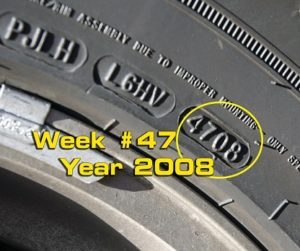
Every legal tire should have a DOT code on its sidewall, where the last four digits are their manufacture date. The first two represent the week, and the last two – the year. So, a tire with the code 1612 was made during the 16th week of 2012. If there is no DOT code on the tire you are about to buy, this means it’s illegal for usage in North America. You can learn more on tire date codes from this article.
A used winter tire can operate well for up to 4-5 seasons, so look for tires that are 2-3 years old. If you mount an old tire even with plenty of tread left, you won’t get much of a performance and will endanger your safety. Rubber starts deteriorating and losing its flexibility over time, and this is one of the most important features for driving in winter.
Size and Vehicle Compatibility
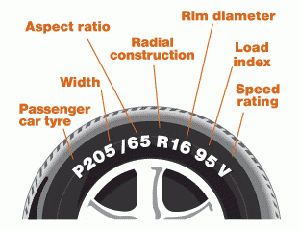
The first thing to do is to look at the door edge to see the recommended size(s) for your particular vehicle. There will be a code like P205/65R16, where:
- P means Passenger (can also be LT which stands for Light-Truck, or ST – Special-Trailer).
- 205 means the tire width in millimeters.
- 65 is an aspect ratio or profile (the relation between the width and the height in percent, meaning the height is 65% of the width).
- R stands for Radial (the tire’s construction type; there may also be “-“ or D for Bias/Diagonal and B for Bias-belt)
- 16 indicates the rim diameter in inches.
The used winter tire you choose has to be of the recommended size to fit your vehicle. To learn more about sizes compatible with your car, read the owner’s manual. If you decide to change the size of your winter tires, consider buying new rims as well. This will prevent tire tear during mounting and demounting.
A Look into OE Tires
You won’t confuse the size of the tire if you buy OE (original equipment) used tires. You can find which tires are OE for your vehicle in the owner’s manual or online. Some websites selling used tires may have search tools that will help you find OE tires. For example, on our website, you can use the search tools to find Federal tires suitable for your vehicle.
When searching for a winter tire, pay attention to special codes – some vehicle manufacturers mark their OE tires. For example:
- BMW and Mini have a star symbol.
- Mercedes has MO, MO1, or MOE.
- Porsche has N and a number.
- General Motors has a special Tire Performance Criteria Specification (TPC Spec) code.
OE tires don’t always provide the best performance, but they fit your car perfectly. They work equally adequately according to all criteria, such as traction, rolling resistance, noise, etc. However, if you need less rolling resistance or increased traction tire, you may want to search for a different tire.
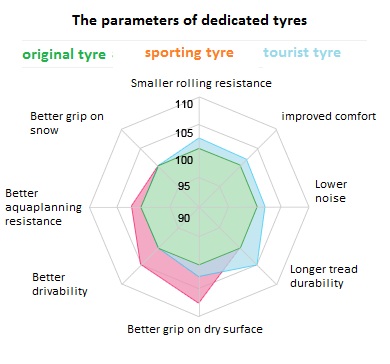
NOTE: When choosing a used winter tire, look for a set that has the same type and size. Choose all radial and all 225/65, for example, as this will provide you with the best stability and performance.
The Amount of Tread
According to TireRack’s specialist, snow tires are useless when the tread depth reaches 6/32”-5/32”. The legal tread depth minimum is 2/32” in 42 states of the US, which may be too shallow even for regular roads. A used winter tire can be up to 10/32”-11/32”, as much as a new tire, if their owner didn’t drive even a thousand miles.
5/32” is a total minimum, as after this point, a snow tire can’t bite into snow as efficiently anymore. The ride will become more slippery, the braking distance will increase, and the handling will become worse. The deeper the tread, the less snow buildup in the grooves. Also, special rubber compounds like silica may wear out completely at 5/32”. So even with great looks, the tire may have only all-season level snow grip.
Besides, a used winter tire with plenty of tread has a unique pattern which includes shallower grooves and sipes. The grooves between the tread blocks channel snow and dissipate water, while the sipes bite into snow, providing traction. So the depth of these elements is crucial for good performance.
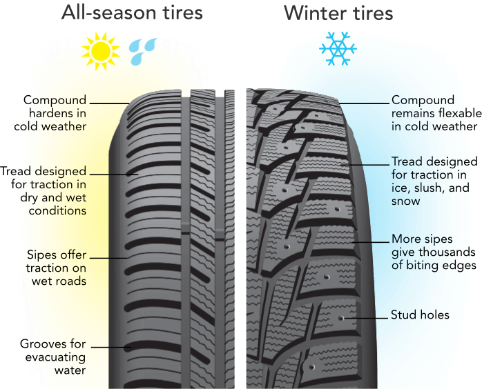
Before buying snow tires, check their tread depth in different spots around the circumference. Don’t buy the tires that are 5/32” already, as they will not provide you with stable performance during the whole season. Go for at least 8/32”, which is the average, to make sure the tire will work for 1-2 seasons. You can find more information on used tires tread here.
Treadwear Pattern
When searching for a used winter tire, always look for uneven wear, such as:
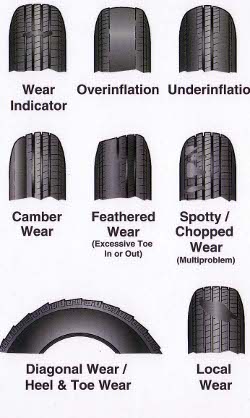 Camber (one-shoulder) wear.
Camber (one-shoulder) wear.
Excessive wear on the inside or outside edge, or a shoulder. Causes include suspension misalignment, worn or broken spring, a bent stut, etc.- Center wear.
Excessive wear in the center of the tire is in most cases a sign of over-inflation. - Two-shoulder wear.
Excessive wear on both shoulders most often indicate under-inflation. - Feathering.
The tread feels harsher when rubbing to one side than to another. The most frequent cause is a wrong toe setting, bent steering arms, or worn tie rod ends. - Cupping.
Excessive wear in regular spots across the tire’s edge may be a sign of tire imbalance or suspension problems. - Patch-wear.
Irregular flat spots on a used winter tire mean it’s imbalanced and the prior owner was driving it like that for a long time.
You can spot irregular wear by looking at the tire or measuring its tread depth in different spots across the item. If you spot any of the aforementioned patterns, don’t buy the tire as it won’t provide good performance and may become dangerous.
Absence of Damages and Repairs
Before buying a used winter tire, look for the following damages:
- Exposed cords.
Severe uneven wear or another kind of damage may cause cord exposure. If you see even a little bit of a metal wire, consider the tire dangerous. - Belt separation.
Look for bumps or waves on the tire – they may be a sign of belt separation. When the tires are off the rims, this may be not visible on sight. So, you should run your hand around the tread and sidewalls to spot them. - Liner damage.
Look at the liner for excessive wear, exposed cords, or other damages. If you find rubber dust or a softer line of rubber inside the tire’s sidewalls, consider it dangerous. The sidewalls may collapse any moment. - Bead damage.
If you see any chunks absent from the bead of a winter tire, stay away from it. Such a tire won’t hold to the rim and will lose air quickly. - Cuts, plugs, holes, cracks etc.
Obvious damage like cuts from sharp objects, small tears, plugs, holes, etc. mean the tire isn’t fit for purpose. Cracks usually appear from age, and they tend to expand rapidly, causing tire failure. Such tires shouldn’t be used on a car under any circumstances, especially in winter.
As for repairs, properly plugged snow tires may work adequately. However, only plugs are acceptable, as small holes caused by nails are well-reparable. If you notice any external patch hiding a screw penetration or other irreparable damages, don’t buy those used tires.
Do’s and Don’ts of Buying a Used Winter Tire
Do’s
-
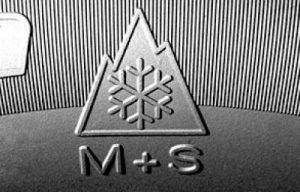
Winter tire symbol Make sure you look at a winter tire.
A used winter tire, as well as a new one, will have a special “Three-Peak Mountain Snowflake” symbol (3PMSF). In the US, the tires get the symbol after they pass the ASTM International Standard Test. Such tires have special rubber compounds that are more flexible and work best at 45°F (7°C) and below. - Research the tires as if you were to buy new.
Do your research before buying a used winter tire by reading all the codes on the tire’s sidewall, searching for reviews online, etc. The tire codes can tell you about the speed of tire treadwear, the temperature the item can withstand, its size, age, maximum speed and load, and more. The reviews can show you whether the customers who buy new or used tires of that model are satisfied with it. - Inspect the tire carefully.
Although the Rubber Manufacturers Association (RMA) attempts to control the used tires industry, caution is still the top priority. Aside from checking all of the aforementioned things, ask about the past of a used winter tire you want to buy. Maintenance issues like driving on an under-/over-inflated tire, improper storage, etc. may impact its internal structure greatly. - Check for recalls.
Copy the code of the tire and check it online by using the RMA’s Tire Recall Lookup. Insert the DOT code in the respective field and you will get the necessary information. Used tires may go from shop to shop, so the details of their condition may be unknown. Besides, some sellers may take the risk of selling recalled tires in good condition intentionally.
Don’ts
- Don’t buy only one or two winter tires.
When looking for a used winter tire, think about a set. A pair of specialized items won’t prevent an uncontrolled pinwheel. As this test shows, a mix of all-season and winter tires provide reduced handling and a rather dangerous ride. - Don’t wait till late fall or winter to buy tires.
Snow tires become available in the fall, so you should buy yours at once and not wait for the leftovers. In winter, the range of the tires may be much smaller, and for used tires, a wide range is a high priority.
Other Things to Consider When Choosing a Used Winter Tire
- Think of your climate and driving conditions.
Mild winters with relatively warm temperatures and no snow don’t require winter tires. However, if you live in northern states and your winters go below 45°F (7°C), you need them. All-season or M+S (Mud+Snow) tires won’t provide you with enough performance in cold temperatures. Their tread pattern doesn’t always have sipes to bite into snow, and the compounds in the rubber may be not hydrophilic (water-loving) enough to provide grip. 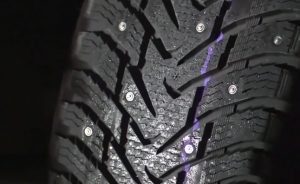 Consider studded tires.
Consider studded tires.
If the surfaces you drive on are covered with packed snow and layers of ice, try studded tires. Such items have metal or ceramic “teeth” that help move through slippery ice and snow. They provide better grip on such surfaces, especially if you are going off-the-road in winter. However, studdable tires have two major disadvantages: they are very noisy, and they damage regular pavement. Some states ban studded tires, so make sure you check with the authorities before buying a used winter tire with teeth. You may be better off buying studless tires.
- Consider buying rims for the winter tires as well.
Mounting tires every season may be expensive and dangerous, as you may damage the bead. Besides, some tires may be good for your car and driving conditions, but not fit for the rims. In such cases, it’s better to purchase rims/wheels (new or used) as well. Before you decide, check whether your wheels have tire pressure monitoring system (TPMS) If so, you will have to buy those for your new ones too.
Should I Buy a Used Winter Tire?
Buying used tires is beneficial for those who have a limited budget, as the price is usually at least 30%-50% less. Besides, you help the environment, as the tires don’t end up in landfills. Here are more details on why buying used tires is a good idea.
However, there are also potential pitfalls of buying used tires, such as internal damages that are hardly visible, limited tread, etc. You should also be cautious of lying sellers that offer obviously totaled tires. You can find more information on why buying used tires may be non-beneficial in this article.
Share the Knowledge
